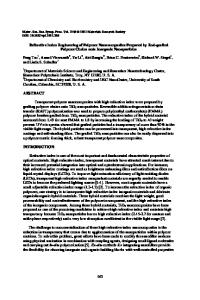Wetting on Grafted Polymer Films
- PDF / 4,270,931 Bytes
- 5 Pages / 576 x 777.6 pts Page_size
- 5 Downloads / 304 Views
MRS BULLETIN/JANUARY 1997
prene block copolymer exhibits a lamellar structure. When annealed its surface is covered by a polyisoprene layer since polyisoprene has a lower surface tension. Therefore at room temperature, one gets a molten polyisoprene brush with isoprene chains anchored to a glassy PS layer. One can also spread thin copolymer layers on solid or polymer substrates to obtain nicely structured systems covered by brushes. This offers remarkable possibilities for controlling the surface properties. By an appropriate choice of the block that covers the surface, one can get a brush that is rubbery or glassy. Changing the temperature in the glass-transition re-
gion of the brush varies the wetting, adhesive, and friction properties of surfaces by many orders of magnitude. Wetting Autophobicity The very properties of polymer brushes arise from the topological constraints imposed on chains by end grafting.2 Consider a surface on which A chains of N monomers are end-anchored so that the surface area per chain is a-"1 (Figure la). On the local scale, molten brushes behave like incompressible liquids. Hence the brush thickness is h0 = Ncrv with v being the volume per monomer in an A polymer melt. When the grafting density is high, the brush thickness can be greater than the average end-to-end distance R = Nina that the chain would have in a melt (a denotes the monomer length). As a result, the covalent anchoring of just one monomer per chain leads to interesting long-range entropic effects. Chain configurations in a brush are not random walks like in polymer melts but instead are distorted. An internal pressure field exists, which ensures that the density is uniform. Semenov3 has shown that this pressure field is not constant: Chains are more stretched near the solid surface to which they are attached than near the air-brush interface.
air
Figure 1. Schematic representations of dense end-anchored polymer layers, (a) Dense layer formed by adsorption of end-functionalized polymers, (b) Brush formed at the surface of a microphase-separated copolymer melt.
33
Wetting on Grafted Polymer Films
Figure 2. Atomic-force-microscopy micrographs showing the spreading of a tiny poly(styrene) (PS) droplet (volume of the droplet: 3 x 10 9cm3, molecular weight: Mws 4,500) on the surface of an ordered PS-poly (methylmethacrylate) (PMMA) diblock copolymer film (PS-PMMA, molecular weight: Mw= 91,000). The film thickness, 54.6 nm, corresponds to three PS-PMMA monolayers. The block exposed to vacuum is PS. (a) After a one-hour annealing at 170°C. (b) After a seven-hour annealing at 170°C.
If the brush polymers had the choice, they would prefer to be less densely grafted. Clearly the response of such a constrained system to osmotic or mechanical perturbations is completely different than that of a usual nonattached polymer layer. In many respects, the situation is analogous to that of rubbers, which are also polymer liquids, in which the presence of topological constraints (crosslinks) leads to nonliquidlike behavior on a macr
Data Loading...










